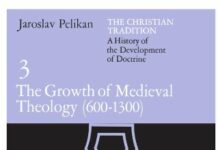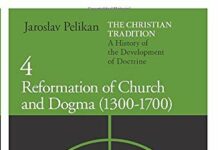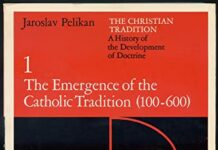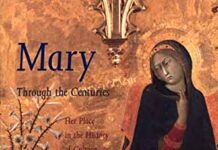
Ebook Info
- Published: 2006
- Number of pages: 288 pages
- Format: PDF
- File Size: 8.08 MB
- Authors: Jaroslav Pelikan
Description
Jaroslav Pelikan, widely regarded as one of the most distinguished historians of our day, now provides a clear and engaging account of the Bible’s journey from oral narrative to Hebrew and Greek text to today’s countless editions. Pelikan explores the evolution of the Jewish, Protestant, and Catholic versions and the development of the printing press and its effect on the Reformation, the translation into modern languages, and varying schools of critical scholarship. Whose Bible Is It? is a triumph of scholarship that is also a pleasure to read.
User’s Reviews
Editorial Reviews: Review “A crisp, remarkably succinct history of the Bible as preserved, interpreted, translated and canonized by the various faiths that believe in it.” —Los Angeles Times”Engaging . . . an excellent overview.” —The New York Times Book Review”Outstanding . . . Pelikan takes the reader through the process of scripture building with a fluency and ease that is both accessible and understandable.” —Publishers Weekly (starred review)”Masterly . . . Pelikan weaves a tapestry of the power of the Word to mold religious communities, nations, and culture. . . . Engaging, concise, and highly readable.” —The Christian Science Monitor From the Back Cover “An engaging and highly readable survey of biblical scholarship that tells a fascinating and complex story.” The Wall Street Journal “A crisp, remarkably succinct history of the Bible as preserved, interpreted, translated and canonized by the various faiths that believe in it.” Los Angeles Times “Engaging . . . an excellent overview.” The New York Times Book Review “Outstanding . . . Pelikan takes the reader through the process of scripture building with a fluency and ease that is both accessible and understandable.” Publishers Weekly (starred review) “Masterly . . . Pelikan weaves a tapestry of the power of the Word to mold religious communities, nations, and culture. . . . Engaging, concise, and highly readable.” The Christian Science Monitor About the Author Jaroslav Pelikan is Sterling Professor Emeritus of History at Yale University and past president of the American Academy of Arts and Sciences. His many books include the five-volume The Christian Tradition, Jesus Through the Centuries, and Mary Through the Centuries. He has received the Thomas Jefferson Medal of the National Endowment for the Humanities and an honorary degree from the Jewish Theological Seminary of America as well as forty-one other honorary degrees. Read more
Reviews from Amazon users which were colected at the time this book was published on the website:
⭐Pelikan’s work “Whose Bible is It?” is a vague work, perhaps better for the casual reader than the scholar. Of particular interest is Pelikan’s emphasis on the Jewish perspective of the Bible. Although Pelikan is a historian, his work here breaks into theology at times with comments here and there, and in an ecumenical and modern perspective (using the term “ecumenical” in the contemporary sense of the word).What do we mean by Old and New testament? What do we mean by “canon”? What place does the Bible have in tradition, if at all? How does oral tradition relate to the Bible, which is arguably the result of written tradition? These questions and more Pelikan addresses here. It’s fairly liberal, and like I said earlier, casual. If you’re a scholar, or someone seriously studying the Bible, I’d look elsewhere. I respect Pelikan’s work, so I think he was merely catering for a broader audience in this book.
⭐Important and powerful and fundamental book on the history of the scriptures and how Jews, Catholics, and Protestants have canonized, translated (and mis-translated), interpreted (and mis-interpreted) them throughout history and into today. The writing isn’t as accessible to the masses as it could be, but still enjoyable read, mainly because of the subject matter.
⭐This is a very good analysis of the organization of the modern Bible and the changes its undergone in the past 2000 years. Author Pelikan has organized a concise history book and a good overview of the various religious sects and how they’ve put their own spirtuality into book format.Jews and Christians, specifically Protestants and Catholics, have argued theolgy for centuries only to agree to disagree on most major topics. The western world has taken the process a step or two further when they translated the original scriptures into their own languages. Guttenberg, the King James Version, American Standard, etc. have all attempted to become definitive translations. Interestingly each succeeeded and failed at the same time. Nearly every Bible translator sets out to do the best their abilities and knowledge will permit, but each must make important decisions on what and what not to include. Since few people read Hebrew and Greek, translations are inevitable, and we all must learn to live with the results. Modern technology has made nearly any Bible currently in print available, so read what suits you.Pelikan treds a path through the variations not formally endorsing any specific one. His knowledge of his topic and his writing style makes this a very good book that Biblical scholars on down to church librarians will want to include in their collections. The book would have been helped had an index been included, but this is but a minor flaw in an otherwise very commendable effort.
⭐Pelikan writes in an easy style and smoothly flowing perspective born of his own long familiarity with the material. He chronicles the formation of the texts known as the Old and New Testaments from their earliest oral traditions. It becomes clear that through long years and re-scribing and translating the Bible, it has been in evolution. The major effort in recent years is to return to the earliest accurate version available, and that this requires considerable scholarship to accomplish.Pelikan is strong in his description of the influences of various denominational decisions and later the conclusions of the historical-critical model on the understanding of the Bible today. He gives less time to more recent scepticism of some of these conclusions. He seems at times to being avoiding controversy by reaching softer conclusions than may be warranted by his data. Perhaps this represents the wisdom of age.His was an ambitious undertaking and he carried it off well, it is a readable and enjoyable book, informative and insightful.
⭐Fast delivery, price was great! However, when I mentioned something found in my book, I was immediately refunded the full price. I only mentioned this to make the seller aware but they insisted on a full refund. I would definitely do business with this seller again and again!
⭐Pelikans’s “Whose Bible Is It?” does not truly seek to answer the question posed in the title. Instead, the author, a acclaimed, able, and recently deceased professor at Yale provides a historic overview of Biblical development, particularly as it applies to the Christian era of the past 2000 years. While the author gives attention to the Jewish Biblical tradition, he spends a relatively short part of this extremely short work reviewing the Bible’s pre-Christian development. One can well forgive this choice, since biblical origination is a topic requiring a great deal of conjuncture and anthropological analysis, while also being treacherously fraught with political and religious conflict.Pelikan’s makes a few mistakes along the road. For example he lumps Orthodox Jewish epexegesis in with the literalism of the Christian analytical tradition, a proposition proved demonstrably false by Maimonidies commentary on the Bible as metaphor and Nachmanidies positions on Genesis, such as positing that a day in the human experience is not the same as creations 7 days which refers to days in the life of G-d. Curiously, Jewish tradition, occupying a position of weakness in the social scheme generally allowed a greater diversity of textual approaches than the far more powerful Christian majority.In the end Pelikan’s text includes one overriding weakness; he never tells the reader definitively where he stands. One gets to the end of what seems an overly long introductory essay, only to find an all too brief conclusion that never lets us know this scholars answer to this important question. If he had a deep answer, it seems one he took with him to his grave.
⭐A must for anyone contemplating a journey along the Camino
⭐Though probably the most read “book” in the western hemisphere, and certainly the most ubiquitous – thanks partly to the Gideons, as the author points out – very few will know the history of the Bible, nor the relationships between the Talmud, the Catholic and Protestant Bibles, and the Qu’ran. In Whose Bible Is It? Jaroslav Pelikan joins the dots, relating the development of the Bible from its Judaist origins, identifying the different types of book to be found there – the Bible is more like a library of books than a book in its own right – revealing the way in which the Old Testament was augmented by the New, and explaining the difficulties involved in translation.First of these is that much of the source material is effectively a string of capital letters without vowels, gaps or punctuation, another that some of the words are untranslatable – nobody, not even the rabbinical scholars maintaining the Judaist oral tradition, knows what they mean. But even where they do, the meaning has been lost through translation and misinterpretation, perhaps for dramatic, perhaps for less innocent, purposes. So, just as Robert Alder, in his translation of Genesis, points out that nowhere in the first book of the Bible is Joseph’s coat described as multicoloured (it is “patterned”), so Pelikan reveals that Mary is referred to as a young woman, not a virgin.The chronology of the books is also revealing: the four gospels, for example, post-dated the crucifixion by several decades – over a century in the case of John, the final one to be written. The fact that there are indeed four gospels, and that they are so different, despite the overlaps (well-recorded in JW Rogerson’s An Introduction to the Bible), is in itself worthy of note – what grand cosmic plan issues four different versions of its own backstory for its adherents to squabble and puzzle over?In discussing the historical-critical method Pelikan reminds us that, though many of the personalities featured in the Bible, and the events, too, are based on actuality, the Good Book’s adherence to historical verisimilitude is notoriously relaxed. The flight from Egypt, for example, would have left a crisis-inducing hole in the Pharaoh’s economy. None such is documented by the famously record-retentive Egyptians.Similarly, convention has it that the Christ was born in 7-6 BCE; some commentators have the Augustine census which forms the context for the Nativity occurring in 6 CE (though Pelikan himself writes that no record of this census exists); Herod, the instigator of the “subsequent” massacre of the first-borns, died in 4 BCE. Hmm. Pelikan discusses some of these issues, and points out the resultant difficulties they pose for the faithful, without drawing any conclusions.He does concede that maybe the Creation story, together with those of the Garden and the Flood, should be taken as allegory. But the central assumption throughout is that despite the narrative contradictions there is something more to the Bible than a selectively assembled set of fables about the development of Western values. That this is the Bible’s true worth is missed. It is noted that there is a switch from Lord of Hosts (the Hosts being armies, he informs us) in the Old Testament to Prince of Peace in the New. The irony is overlooked that Joshua in the Old is an invading militarist whilst his namesake in the New (known to the Greeks as Jesus) is a healer. The anomalies inherent in the acceptance of concubinage, polygamy and slavery are noted with no more than apparent puzzlement. Same applies to the conundrum of Abraham’s near infant sacrifice, so ably satirised in Bob Dylan’s Highway 61 and Jenny Diski’s After These Things. What possesses a father to terrorise his son in such a manner? What kind of megalomanic, tyrannical, supreme being is it that expects this cruelty to be inflicted? But again these difficulties are mentioned in passing and we move on.So although this book is enlightening in many ways, I was left with a feeling of unfinished business. Don’t just write there, defend this ludicrous theology of yours!To be fair, however, Pelikan never purports to be unravelling the inconsistencies of religion. He is chronicling the development of the Bible to its present manifestations, and in that he does very well.So why just four stars? The Structure: at no time did I get a feel for where we were going until the Afterword, at which point I got an inkling we might be near the end. No Index. No Bibliography.
⭐I’m a layman who’s interested in biblical history and theology. I find this book is a great resource for understanding the historical origins of the holy books of Judaism, Christianity and Islam. I’m now a fan of jaroslav pelikan and will be reading more of his books.
⭐Good coverage of the history of the Bible. Takes the reader through the whole process of the development of Biblical scripture. Very good for undergraduate study of the history of scripture. You need to be ready to put the pieces together yourself. Quite educational.
⭐Excellent book to read for those who thirst to know about the historical background of the Bible
Keywords
Free Download Whose Bible Is It? : A Short History of the Scriptures in PDF format
Whose Bible Is It? : A Short History of the Scriptures PDF Free Download
Download Whose Bible Is It? : A Short History of the Scriptures 2006 PDF Free
Whose Bible Is It? : A Short History of the Scriptures 2006 PDF Free Download
Download Whose Bible Is It? : A Short History of the Scriptures PDF
Free Download Ebook Whose Bible Is It? : A Short History of the Scriptures



